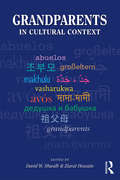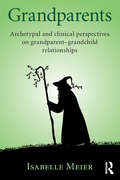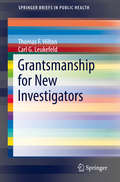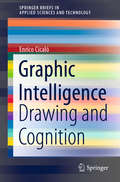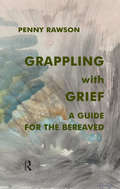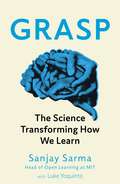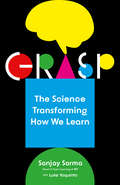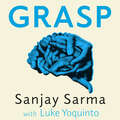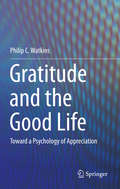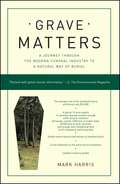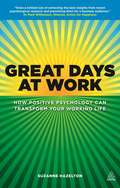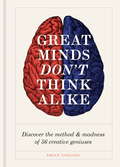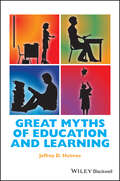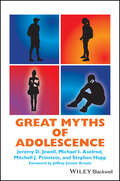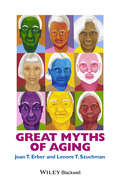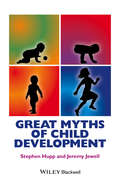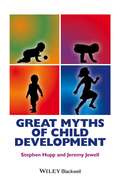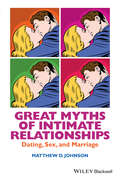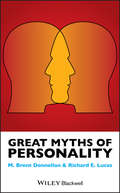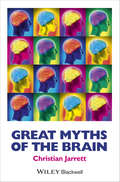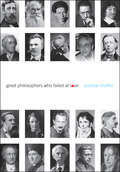- Table View
- List View
Grandparents in Cultural Context
by David W. Shwalb Ziarat HossainGrandparents in Cultural Context gives a long overdue global view of the changing roles of grandparents. The eleven main chapters are by experts in the Americas, Europe and Russia, Asia, and Africa and the Middle East, and the editors integrate their chapters with previous writings on grandparenthood. Rather than technical or statistical research reports, each chapter provides a thought-provoking and comprehensive review of research, real-life case stories, cultural influences, and applied implications for grandparenthood across and within societies. Calling special attention to the roles of grandfathers and grandparenthood in societies previously un-represented in the literature, it provides several hundred new citations of work previously unavailable in English-language publications. Accessible to both scholars and students, it has several pedagogical features (e.g. web links, discussion questions) that make it useful as a text for upper-division undergraduate or graduate level classes in behavioral, social, and family sciences. It is relevant to psychology, gerontology, family studies, anthropology, family/comparative sociology, education, social work, gender studies, ethnic studies, psychiatry, and diversity and international studies programs. Practitioners, service providers, policymakers, and internationally minded grandparents will also enjoy this book.
Grandparents: Archetypal and clinical perspectives on grandparent-grandchild relationships
by Isabelle MeierIsabelle Meier presents a unique examination of the relationship between grandparents and grandchildren, viewed through the lens of analytical psychology. This relationship can have a huge impact on psychological development, yet it has been largely neglected in studies of the family. Meier explores both clinical and theoretical material throughout the book. In the first part she dissects archetypal images in the intergenerational relationship, particularly as shown in fairy tales, myths and legends. From the ‘wise old woman/man’ to the ‘wicked witch’ or the ‘old wizard’, memories and experiences of these archetypes can be stored in the implicit memory and activated later in life. The second part looks at the processes and functions of implicit memory and examines the concept of the complex as it applies to grandparents, using Stern’s studies on the present moment and intersubjective phenomena. Finally, in part three, Meier presents case studies from her own practice. Grandparents will be essential reading for Jungian analysts and psychotherapists, analytical psychologists and those in training. It will also be of interest to academics and students of Jungian studies, myth and anthropology, and readers looking to explore intergenerational family relationships.
Grantsmanship for New Investigators (SpringerBriefs in Public Health)
by Carl G. Leukefeld Thomas F. HiltonThis compact resource analyzes and demystifies the processes of applying for, competing for, and getting funding for research. Neither a cookbook nor a template, it encourages readers to apply the critical thinking and attention to detail they use in their investigations to the pursuit of the grant. Chapters delve into choosing among funding options, project planning and writing, filling out the materials in the application packet, and troubleshooting for problems at various steps of the journey. Along the way, the authors also explore common myths of grantsmanship and alert readers to hidden pitfalls that can get an otherwise good submission rejected. Among the core skill areas covered: · Using strategic thinking throughout the application process · Understanding the major grant mechanisms · Navigating the grant timeline, including the peer review and the vetting process · Writing the effective project description · Following up if the project is not funded or funding is deferred · Building a career grant by grant Brimming with expert knowledge, Grantsmanship for New Investigators ably balances motivation with realism. The authors’ deep understanding and experience of how funding agencies arrive at judgments will inspire readers to present their research in the most convincing manner.
Graphic Intelligence: Drawing and Cognition (SpringerBriefs in Applied Sciences and Technology)
by Enrico CicalòThis book demonstrates and discusses the hypothesis that, within the theory of multiple intelligences, graphic intelligence can be isolated and defined as the ability to use graphic skills to solve problems and create products through the integration and coordination of eye, mind and hand, that is, visual perception, thought and graphic representation. Since it is essential to the development of thought in various disciplinary and professional fields, graphic intelligence is considered an intellectual skill that needs to be taught not only in specialist training, but also in general training and at all levels of education, from pre- and primary school to higher education. The book discusses the role of graphic intelligence within the design, scientific, artistic, education and communication disciplines, highlighting how graphic skills are fundamental to enhancing cognitive and imaginative abilities in all areas of training and professional knowledge.
Grappling with Grief: A Guide for the Bereaved
by Penny RawsonThis book looks at different ways of going through a loss of any kind. The author draws examples from her experience as a psychotherapist and counsellor and offers the readers the chance to learn about different ways of grieving, as well as make them see that they are not alone in their grief. The language is free of jargon and the book manages to tackle this difficult subject with the dignity it deserves. The author also offers practical information on the "symptoms" of people faced with loss, her view on the different cycles of grief as well as advice to people close to a grieving person.
Grasp: The Science Transforming How We Learn
by Sanjay Sarma Luke Yoquinto'Sarma's book may be the most important work on education written this century' - SkepticAs the head of Open Learning at MIT, Sanjay Sarma has a daunting job description: to fling open the doors of the MIT experience for the benefit of the wider world. But if you're going to undertake such an ambitious project, you must first ask: How exactly does learning work? What conditions are most conducive? Are our traditional classroom methods - lecture, homework, test, repeat - actually effective? And if not, which techniques are?Grasp takes readers across multiple frontiers, from fundamental neuroscience to cognitive psychology and beyond, as it explores the future of learning. For instance:· Scientists are studying the role of forgetting, exposing it not as a simple failure of memory but a critical weapon in our learning arsenal· New developments in neuroimaging are helping us understand how reading works in the brain. It's become possible to identify children who might benefit from specialised dyslexia interventions - before they learn to read· Many schools have begun converting to flipped classrooms, in which you watch a lesson at home, then do your 'homework' in classAlong the way, Sarma debunks long-held views such as the noxious idea of 'learning styles,' while equipping readers with a set of practical tools for absorbing and retaining information across a lifetime of learning. He presents a vision for learning that's more inclusive and democratic - revealing a world bursting with powerful learners, just waiting for the chance they deserve.Drawing from the author's experience as an educator and the work of researchers and educational innovators at MIT and beyond, Grasp offers scientific and practical insight, promising not just to inform and entertain readers but to open their minds.
Grasp: The Science Transforming How We Learn
by Sanjay Sarma Luke YoquintoA groundbreaking look at the science of learning—how it's transforming education and how we can use it to discover our true potential, as individuals and across society by a renowned MIT professorAs the head of Open Learning at MIT, Sanjay Sarma has a daunting job description: to fling open the doors of the MIT experience for the benefit of the wider world. But if you're going to undertake such an ambitious project, it behooves you to ask: How exactly does learning work? What conditions are most conducive? Are our traditional classroom methods—lecture, homework, test, repeat—actually effective? And if not, which techniques are? Grasp takes readers across multiple frontiers, from fundamental neuroscience to cognitive psychology and beyond, as it explores the future of learning. Some of its findings: • Scientists are studying the role of forgetting, exposing it not as a simple failure of memory but a critical weapon in our learning arsenal. • New developments in neuroimaging are helping us understand how reading works in the brain. It's become possible to identify children who might benefit from specialized dyslexia interventions—before they learn to read.• Many schools have begun converting to flipped classrooms, in which you watch a lesson at home, then do your 'homework' in class. Through such bold instructional changes, MIT has eliminated the gender performance gap in its introductory physics courses.• By structuring its curriculum to better incorporate cutting-edge learning strategies, one law school in Florida has rocketed to the top of its state in bar exam passage rates. Along the way, Sarma debunks long-held views (such as the noxious idea of "learning styles"), while equipping readers with a set of practical tools for absorbing and retaining information across a lifetime. He presents a vision for learning that's more inclusive and democratic—revealing a world bursting with powerful learners, just waiting for the chance they deserve. Drawing from the author's experience as an educator and the work of researchers and educational innovators at MIT and beyond, Grasp offers scientific and practical insight, promising not just to inform and entertain readers but to open their minds.
Grasp: The Science Transforming How We Learn
by Sanjay Sarma Luke Yoquinto'Sarma's book may be the most important work on education written this century' - SkepticAs the head of Open Learning at MIT, Sanjay Sarma has a daunting job description: to fling open the doors of the MIT experience for the benefit of the wider world. But if you're going to undertake such an ambitious project, you must first ask: How exactly does learning work? What conditions are most conducive? Are our traditional classroom methods - lecture, homework, test, repeat - actually effective? And if not, which techniques are?Grasp takes readers across multiple frontiers, from fundamental neuroscience to cognitive psychology and beyond, as it explores the future of learning. For instance:· Scientists are studying the role of forgetting, exposing it not as a simple failure of memory but a critical weapon in our learning arsenal· New developments in neuroimaging are helping us understand how reading works in the brain. It's become possible to identify children who might benefit from specialised dyslexia interventions - before they learn to read· Many schools have begun converting to flipped classrooms, in which you watch a lesson at home, then do your 'homework' in classAlong the way, Sarma debunks long-held views such as the noxious idea of 'learning styles,' while equipping readers with a set of practical tools for absorbing and retaining information across a lifetime of learning. He presents a vision for learning that's more inclusive and democratic - revealing a world bursting with powerful learners, just waiting for the chance they deserve.Drawing from the author's experience as an educator and the work of researchers and educational innovators at MIT and beyond, Grasp offers scientific and practical insight, promising not just to inform and entertain readers but to open their minds.
Gratitude and the Good Life
by Philip C. WatkinsThis book provides clear and sometimes surprising answers to why gratitude is important to living well. The science of gratitude has shown much growth in the last ten years, and there is now sufficient evidence to suggest that gratitude is one of the most important components of the good life. Both correlational and experimental studies have provided support for the theory that gratitude enhances well-being. After providing a lucid understanding of gratitude, this volume explores the many aspects of well-being that are associated with gratitude. Moreover, experimental work has now provided promising evidence to suggest that gratitude actually causes enhancements in happiness. If gratitude promotes human flourishing, how does it do so? This issue is addressed in the second section of the book by exploring the mechanisms that might explain the gratitude/well-being relationship. This book provides an up to date account of gratitude research and suggested interesting paths for future research, all while providing a theory of gratitude that helps make this information more understandable. This book is very valuable to gratitude investigators, as well as all who are interested in pursuing this line of research, students and scholars of emotion and well-being and instructors of positive psychology courses and seminars.
Gratitude: A Way Of Life
by Louise L. HayLouise L. Hay brings you a very special work that is dear to her heart. In Gratitude, Louise has gathered the insights and collected wisdom of some of the most wonderful teachers and writers she knows...people who have demonstrated the power of gratitude in their own lives. Renowned contributors such as Dr. Wayne W. Dyer, Dr. Joan Borysenko, Dan Millman, Harold Bloomfield, M.D., Bernie Siegel, M.D., Shakti Gawain, Dr. Doreen Virtue, and many, many more of her friends...share their understanding of the practice of gratitude with Louise... and with you.
Grave Matters
by Mark HarrisBy the time Nate Fisher was laid to rest in a woodland grave sans coffin in the final season of Six Feet Under, Americans all across the country were starting to look outside the box when death came calling. Grave Matters follows families who found in "green" burial a more natural, more economic, and ultimately more meaningful alternative to the tired and toxic send-off on offer at the local funeral parlor. Eschewing chemical embalming and fancy caskets, elaborate and costly funerals, they have embraced a range of natural options, new and old, that are redefining a better American way of death. Environmental journalist Mark Harris examines this new green burial underground, leading you into natural cemeteries and domestic graveyards, taking you aboard boats from which ashes and memorial "reef balls" are cast into the sea. He follows a family that conducts a home funeral, one that delivers a loved one to the crematory, and another that hires a carpenter to build a pine coffin. In the morbidly fascinating tradition of Stiff, Grave Matters details the embalming process and the environmental aftermath of the standard funeral. Harris also traces the history of burial in America, from frontier cemeteries to the billion-dollar business it is today, reporting on real families who opted for more simple, natural returns. For readers who want to follow the examples of these families and, literally, give back from the grave, appendices detail everything you need to know, from exact costs and laws to natural burial providers and their contact information.
Great Answers to Difficult Questions about Death: What Children Need to Know
by Linda GoldmanDeath is never an easy subject for discussion and adults often struggle to find the right words when talking about it with children. This book explores children's thoughts and feelings on the subject of death and provides parents and other caring adults with guidance on how to respond to difficult questions. The author explores some of the most common questions children ask about death and provides sensitive yet candid answers, phrased in a way that children will be able to understand and relate to. Each chapter is devoted to a particular issue, such as religious beliefs, coming to terms with terminal illness, and the fear of forgetting someone when they are gone. The book recognizes the emotions and reactions of children and family members and includes separate conclusions for parents and children. This guide offers useful advice for parents and carers and will also be of interest to counsellors and other professionals working with children.
Great Days at Work
by Suzanne HazeltonGreat Days at Work will enable you to become more enthusiastic at work, feel more positive and work more effectively with others. Drawing on the latest insights from positive psychology, it outlines practical day-to-day changes you can make immediately for instant benefit, as well as helping you develop a longer term version that means you'll get more out of work. The book is based on a three-layered framework, with the first layer focusing on the mindset for change, the second on personal responsibility, and the third on vision and choice. It reveals how to use these layers to develop an effective perspective on time, embed productive new habits, gain a clear sense of self and work better with others. As a result you will make a bigger contribution to your organization, as well as feeling more engaged, satisfied and in control of your own work and career. Discover how to have a great day at work, every day!
Great Ideas in Psychology: A Cultural and Historical Introduction
by Fathali MoghaddamThis book focuses on the key ideas of the most important modern psychologists. Nineteen classic great ideas in psychology are critically assessed in their cultural and historical context.
Great Minds Don't Think Alike: discover the method and madness of 56 creative geniuses
by Emily GoslingGreat Minds Don't Think Alike surveys some of the most brilliant minds of the past and present. Discover the methods and rituals they used to forge a constructive, creative pathway, from the downright peculiar to the reassuringly pedestrian.Learn the importance of daily routines with Sylvia Plath, embrace randomness with David Bowie and transcend tragedy with Frida Kahlo. With 56 tried and tested creative techniques from inspired, and inspiring, minds - among them, architects, musicians, playwrights, painters and philosophers - enjoy an illustrated compendium of ingenious insights to kickstart your own creative process.
Great Minds Don't Think Alike: discover the method and madness of 56 creative geniuses
by Emily GoslingGreat Minds Don't Think Alike surveys some of the most brilliant minds of the past and present. Discover the methods and rituals they used to forge a constructive, creative pathway, from the downright peculiar to the reassuringly pedestrian.Learn the importance of daily routines with Sylvia Plath, embrace randomness with David Bowie and transcend tragedy with Frida Kahlo. With 56 tried and tested creative techniques from inspired, and inspiring, minds - among them, architects, musicians, playwrights, painters and philosophers - enjoy an illustrated compendium of ingenious insights to kickstart your own creative process.
Great Myths Of Education And Learning
by Jeffrey Holmes Aaron S. RichmondGreat Myths of Education and Learning reviews the scientific research on a number of widely-held misconceptions pertaining to learning and education, from interventions designed to enhance intelligence in infants to strategies used in higher education. A collection of the most important and influential education myths in one book, with in-depth examinations of each topic Focusing on research evidence regarding how people learn and how we can know if learning has taken place, the book provides a highly comprehensive review of the evidence contradicting each belief Topics covered include student characteristics related to learning, views of how the learning process works, and issues related to teaching techniques and testing
Great Myths of Adolescence (Great Myths of Psychology)
by Mitchell J. Prinstein Stephen Hupp Jeremy D. Jewell Michael I. AxelrodA research-based guide to debunking commonly misunderstood myths about adolescence Great Myths of Adolescence contains the evidence-based science that debunks the myths and commonly held misconceptions concerning adolescence. The book explores myths related to sex, drugs and self-control, as well as many others. The authors define each myth, identify each myth’s prevalence and present the latest and most significant research debunking the myth. The text is grounded in the authors’ own research on the prevalence of belief in each myth, from the perspective of college students. Additionally, various pop culture icons that have helped propagate the myths are discussed. Written by noted experts, the book explores a wealth of topics including: The teen brain is fully developed by 18; Greek life has a negative effect on college students academically; significant mood disruptions in adolescence are inevitable; the millennial generation is lazy; and much more. This important resource: Shatters commonly held and topical myths relating to gender, education, technology, sex, crime and more Based in empirical and up-to-date research including the authors' own Links each myth to icons of pop culture who/which have helped propagate them Discusses why myths are harmful and best practices related to the various topics A volume in the popular Great Myths of Psychology series Written for undergraduate students studying psychology modules in Adolescence and developmental psychology, students studying childhood studies and education studies, Great Myths of Adolescence offers an important guide that debunks misconceptions about adolescence behavior. This book also pairs well with another book by two of the authors, Great Myths of Child Development.
Great Myths of Aging (Great Myths of Psychology)
by Joan T. Erber Lenore T. SzuchmanGreat Myths of Aging looks at the generalizations and stereotypes associated with older people and, with a blend of humor and cutting-edge research, dispels those common myths. Reader-friendly structure breaks myths down into categories such as Body, Mind, and Living Contexts; and looks at myths from “Older people lose interest in sex” to “Older people are stingy” Explains the origins of myths and misconceptions about aging Looks at the unfortunate consequences of anti-aging stereotypes for both the reader and older adults in society
Great Myths of Child Development (Great Myths of Psychology)
by Stephen Hupp Jeremy D. JewellGreat Myths of Child Development reveals the latest evidence-based science behind the myths and misconceptions about the developing child. Shatters the most commonly-held child development myths Reveals the science behind such topical issues as twin-telepathy, sex-prediction, and imaginary friends Covers hot-button issues like childhood vaccines, spankings, “time-outs,” and breastfeeding of older children Features numerous pop culture references and examples drawn from popular TV shows and movies, such as Duck Dynasty, Modern Family and Mad Men Points to a wealth of supplementary resources for interested parents—from evidence-based treatments and self-help books to relevant websites
Great Myths of Child Development (Great Myths of Psychology)
by Stephen Hupp Jeremy Jewell<p>Great Myths of Child Development reveals the latest evidence-based science behind the myths and misconceptions about the developing child. Shatters the most commonly-held child development myths Reveals the science behind such topical issues astwin-telepathy, sex-prediction, and imaginary friends <p>Covers hot-button issues like childhood vaccines, spankings, “time-outs,” and breastfeeding of older children <p>Features numerous pop culture references and examples drawn from popular TV shows and movies, such as Duck Dynasty, Modern Family and Mad Men <p>Points to a wealth of supplementary resources for interested parents—from evidence-based treatments and self-help books to relevant websites.
Great Myths of Intimate Relationships: Dating, Sex, and Marriage
by Matthew D. JohnsonGreat Myths of Intimate Relationships provides a captivating, pithy introduction to the subject that challenges and demystifies the many fabrications and stereotypes surrounding relationships, attraction, sex, love, internet dating, and heartbreak. The book thoroughly interrogates the current research on topics such as attraction, sex, love, internet dating, and heartbreak Takes an argument driven approach to the study of intimate relationships, encouraging critical engagement with the subject Part of The Great Myths series, it's written in a style that is compelling and succinct, making it ideal for general readers and undergraduates
Great Myths of Personality (Great Myths of Psychology)
by M. Brent Donnellan Richard E. LucasGreat Myths of Personality teaches critical thinking skills and key concepts of personality psychology through the discussion of popular myths and misconceptions. Provides a thorough look at contemporary myths and misconceptions, such as: Does birth order affect personality? Are personality tests an accurate way to measure personality? Do romantic partners need similar personalities for relationship success? Introduces concepts of personality psychology in an accessible and engaging manner Focuses on current debates and controversies in the field with references to the latest research and scientific literature
Great Myths of the Brain (Great Myths of Psychology)
by Christian JarrettGreat Myths of the Brain introduces readers to the field of neuroscience by examining popular myths about the human brain. Explores commonly-held myths of the brain through the lens of scientific research, backing up claims with studies and other evidence from the literature Looks at enduring myths such as “Do we only use 10% of our brain?”, “Pregnant women lose their mind”, “Right-brained people are more creative” and many more. Delves into myths relating to specific brain disorders, including epilepsy, autism, dementia, and others Written engagingly and accessibly for students and lay readers alike, providing a unique introduction to the study of the brain Teaches readers how to spot neuro hype and neuro-nonsense claims in the media
Great Philosophers Who Failed at Love
by Andrew ShafferFew people have failed at love as spectacularly as the great philosophers. Although we admire their wisdom, history is littered with the romantic failures of the most sensible men and women of every age, including:Friedrich Nietzsche: "Ah, women. They make the highs higher and the lows more frequent." (Rejected by everyone he proposed to, even when he kept asking and asking.)Jean-Paul Sartre: "There are of course ugly women, but I prefer those who are pretty." (Adopted his mistress as his daughter.)Louis Althusser: "The trouble is there are bodies and, worse still, sexual organs." (Accidentally strangled his wife to death.)And dozens of other great thinkers whose words we revere—but whose romantic decisions we should avoid at all costs.Includes an excerpt from Andrew Shaffer's new book Literary Rogues.
